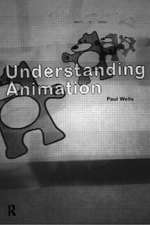Animation and America
Autor Paul Wellsen Limba Engleză Paperback – 29 iul 2002
The "cartoon"in the output of the all conquering Disney studio, the anarchic antics of Bugs Bunny and Daffy Duck in Looney Tunes, and the satiric vision of the Simpsons on television is synonymous with the United States, but the genre rarely is taken seriously. Nevertheless, cartoons are important artistic and cultural achievements, and are an essential ingredient in how America is viewed, both by itself and by others.
In Animation and America, Paul Wells looks afresh at this unique art, discussing the distinctiveness of the cartoon form, as well as myriad other types of animation production. Insisting upon the "modernity" of the genre, Wells examines its importance as a barometer of the social conditions in which it is made and which it reflects. This book is not a standard history of animation in America, but rather uses animation as a way of discussing social and political change. Wells concentrates on the ways in which the form continues to grow, experiment, and remain subversiveand, increasingly, gaining acclaim and recognition. Now in the vanguard of visual culture, animation occupies an important position in representing both the outcomes and impacts of new technologies, and it also has laid the foundations for a new understanding of social and artistic practice.
In Animation and America, Paul Wells looks afresh at this unique art, discussing the distinctiveness of the cartoon form, as well as myriad other types of animation production. Insisting upon the "modernity" of the genre, Wells examines its importance as a barometer of the social conditions in which it is made and which it reflects. This book is not a standard history of animation in America, but rather uses animation as a way of discussing social and political change. Wells concentrates on the ways in which the form continues to grow, experiment, and remain subversiveand, increasingly, gaining acclaim and recognition. Now in the vanguard of visual culture, animation occupies an important position in representing both the outcomes and impacts of new technologies, and it also has laid the foundations for a new understanding of social and artistic practice.
| Toate formatele și edițiile | Preț | Express |
|---|---|---|
| Paperback (2) | 208.98 lei 6-8 săpt. | |
| EDINBURGH UNIVERSITY PRESS – 26 mar 2002 | 208.98 lei 6-8 săpt. | |
| Rutgers University Press – 29 iul 2002 | 283.85 lei 6-8 săpt. |
Preț: 283.85 lei
Nou
Puncte Express: 426
Preț estimativ în valută:
54.31€ • 56.71$ • 44.85£
54.31€ • 56.71$ • 44.85£
Carte tipărită la comandă
Livrare economică 15-29 aprilie
Preluare comenzi: 021 569.72.76
Specificații
ISBN-13: 9780813531601
ISBN-10: 0813531608
Pagini: 192
Dimensiuni: 140 x 216 x 15 mm
Greutate: 0.26 kg
Ediția:None
Editura: Rutgers University Press
Colecția Rutgers University Press
ISBN-10: 0813531608
Pagini: 192
Dimensiuni: 140 x 216 x 15 mm
Greutate: 0.26 kg
Ediția:None
Editura: Rutgers University Press
Colecția Rutgers University Press
Notă biografică
Paul Wells has published widely in the field of animation. He is the author of Understanding Animation and Art and Animation. He also teaches at the University of Teesside (U.K.).
Recenzii
This readable, analytical, and rather full treatment touches on the artistry and the commercial and technical aspects of animation.
Highly recommended.
Descriere
In Animation and America, Paul Wells looks afresh at this unique art, discussing the distinctiveness of the cartoon form, as well as myriad other types of animation production. Insisting upon the "modernity" of the genre, Wells examines its importance as a barometer of the social conditions in which it is made and which it reflects. This book is not a standard history of animation in America, but rather uses animation as a way of discussing social and political change. Wells concentrates on the ways in which the form continues to grow, experiment, and remain subversiveand, increasingly, gaining acclaim and recognition. Now in the vanguard of visual culture, animation occupies an important position in representing both the outcomes and impacts of new technologies, and it also has laid the foundations for a new understanding of social and artistic practice.






















